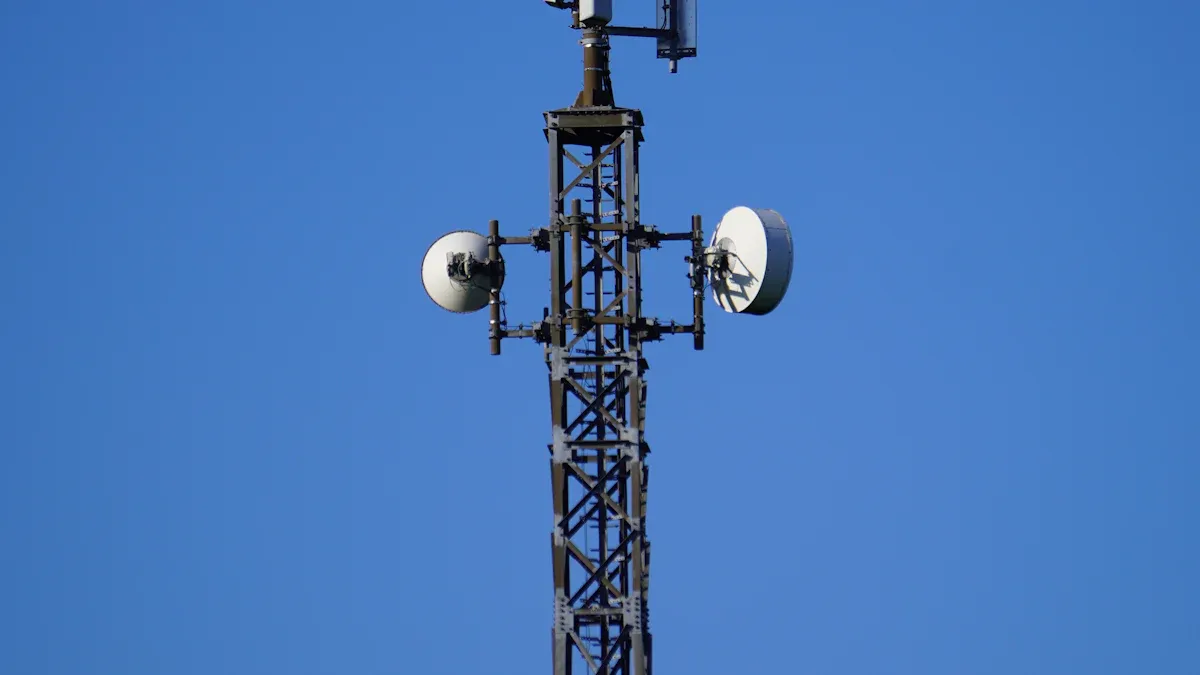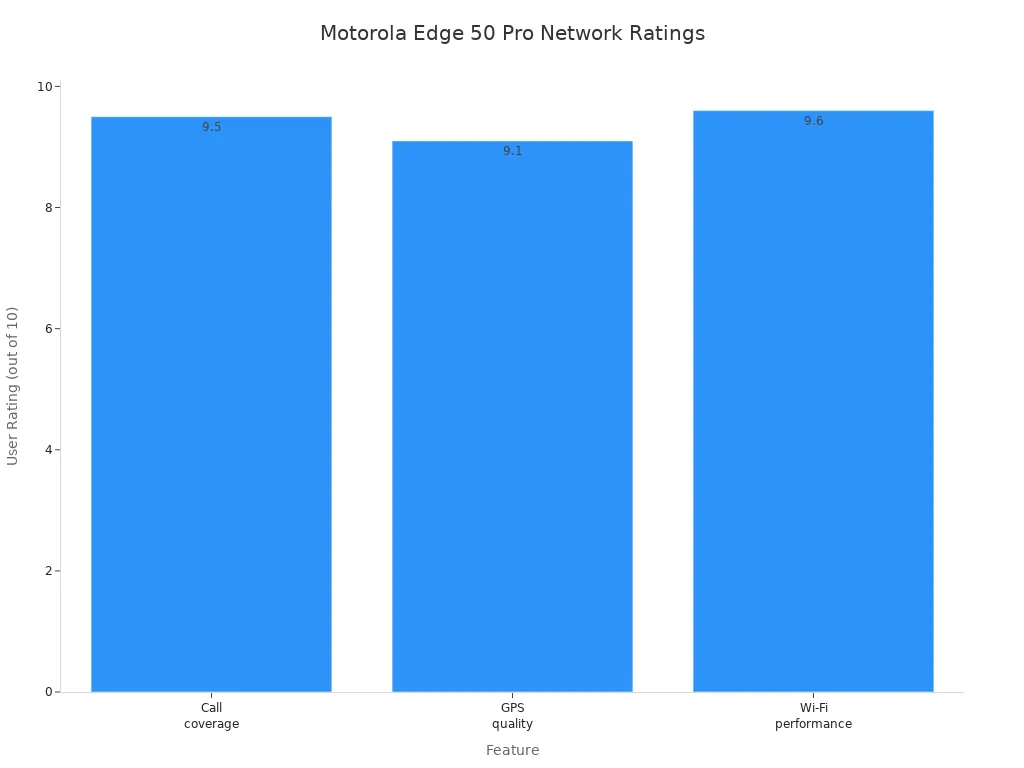
You know how annoying it feels when your smartphone drops a call or loses signal right when you need it most. Maybe you miss an important update or lose touch with family. Around one in nine people in 2023 had problems like this with their smartphones. Even with new tech, many still struggle. Reliable calls matter for work, travel, and daily life. Finding the best smartphones can make a big difference. When you ask, “Which phone has the best network reception and call quality?” you want a smartphone that fits your life, whether you live in a busy city or travel to remote places.
Key Takeaways
-
Good network reception and clear calls help you stay in touch. You need this for work, family, and emergencies. Phones with smart antennas and wide 5G support get better signals. This works in both cities and faraway places. Wi-Fi calling, noise-canceling microphones, and AI signal switching help calls sound better. Pick a phone that works with your carrier’s bands. Make sure it fits how you use your phone every day. Update your software and use Wi-Fi calling to help your signal. Try not to use thick cases because they can block your signal.
Why Network Reception and Call Quality Matter

Everyday Impact
People use their phones for many things. You call friends, join meetings, and talk to family. Good reception helps you hear every word. You will not miss calls. The best signal lets you work from home or travel without dropped calls. Strong signal and high call quality keep you connected everywhere. Many people use 5g for fast and steady connections. With 5g, you get better reception and clearer calls. This is important for work and fun.
A strong network and good reception help you join video calls, send messages, and use apps easily. You feel safe and sure when your phone has the best signal.
-
Good network reception and call quality help you:
-
Keep in touch with family and friends
-
Do your work from anywhere
-
Reach emergency services fast
-
Have smooth video and voice calls
-
Weak Signal Challenges
A weak signal can ruin your day. You might lose a call or have trouble sending texts. Many things can hurt your signal. These include being far from cell towers, thick walls, or bad weather. If you live in the country or travel a lot, it is hard to get the best signal. Even in cities, busy hours can make the signal weak and cause dropped calls.
-
Common problems with signal reception are:
-
Natural things like hills, trees, or mountains
-
Being far from cell towers
-
Different phones have different reception
You face these problems a lot. Getting a phone with the best reception and strong 5g support really helps.
Key Technologies
Phones now use new tech to make signals stronger. Wi-Fi calling lets you make calls over Wi-Fi if your cell signal is weak. This works with your normal phone number. It helps you stay connected inside or far away. Many phones also have 5g for faster speeds and better reception, even far from towers. Some phones use cell signal boosters to make indoor signals stronger. These work like small towers in your house.
-
Important tech for better network reception and call quality:
-
Wi-Fi calling for clear calls over Wi-Fi
-
5g and 5g support for faster, better connections
-
Software updates to help signal reception
-
Cell signal boosters for stronger indoor signal
-
Smart antenna design for the best reception
-
With these features, you get the best signal and call quality wherever you go.
Which Phone Has the Best Network Reception and Call Quality?
If you want to know which phone has the best network reception and call quality, you are in the right place. Here are the top 10 smartphones that do really well with signal reception, antenna strength, and how they work in real life. Each phone on this list gives you great reception, even in hard places. Let’s find out which phone has the best network reception and call quality for you.
Samsung Galaxy S25 Ultra
The Samsung Galaxy S25 Ultra gives you awesome signal reception. Samsung uses a smart antenna system that finds the best signal, even in busy cities or the countryside. The phone works with all main 5G bands, so you stay connected almost everywhere. Many people say the S25 Ultra keeps strong reception inside buildings and while moving. Calls sound clear, and the microphones block out noise around you. If you want a phone with the best signal, this one is a top pick.
iPhone 16 Pro Max
The iPhone 16 Pro Max is always near the top when people ask about the best network reception and call quality. Apple put the antenna bands right into the frame, so you get better signal without extra parts. The phone works with 5G, Gigabit LTE, and Wi-Fi 7, so you get fast and steady connections. You can use eSIM for more carrier choices. The iPhone 16 Pro Max has several microphones with voice isolation, so your calls sound clear, even in loud places. If you lose cell signal, the phone can use satellites for emergency calls. This phone gives you great reception and call strength, no matter where you are.
|
Feature Category |
Description |
|---|---|
|
Antenna Design |
Antenna bands built into the frame; 5G mmWave included (U.S. models) |
|
Cellular Network Support |
5G, Gigabit LTE, VoLTE, Wi-Fi calling |
|
Wi-Fi Technology |
Wi-Fi 7 (802.11be) with 2×2 MIMO for speed and reliability |
|
eSIM Technology |
eSIM for flexible carrier support |
|
Microphones & Audio Modes |
Several mics, Voice Isolation, Wide Spectrum for clear calls |
|
Ultra Wideband Chip |
2nd-gen UWB chip for better device location and network performance |
|
Satellite Connectivity |
Emergency SOS using satellite |
|
GPS & Location Services |
Supports GPS, GLONASS, Galileo, QZSS, BeiDou, NavIC |
Tip: If you travel a lot or live where the signal is weak, the iPhone 16 Pro Max helps you stay connected with its smart antenna and satellite features.
Vertu Quantum Flip
The Vertu Quantum Flip is not just fancy. This phone has strong antenna technology for the best signal. Vertu uses special hardware to boost 5G and LTE signals, so you get strong reception in both cities and faraway places. The call quality is great because of noise-canceling microphones and high-end audio chips. If you want a luxury phone with the best reception, the Quantum Flip is a good choice.
OnePlus 12
The OnePlus 12 is great if you want fast 5G and strong signal. OnePlus uses a wraparound antenna design that finds the best signal, even when you hold the phone in different ways. The phone works with many 5G and LTE bands, so you get good coverage in most places. People say the call quality is clear, and the phone almost never drops calls. The OnePlus 12 is a smart pick if you want a phone with the best signal for daily use.
Google Pixel 9 Pro
The Google Pixel 9 Pro gives you great reception with its smart antenna system. Google uses AI to switch between 5G, LTE, and Wi-Fi for the best signal. The phone supports Wi-Fi calling and has a strong speaker for clear calls. Many people say the Pixel 9 Pro keeps a strong signal, even in buildings or the countryside. If you want a phone that finds the best signal for you, the Pixel 9 Pro is a solid choice.
Sony Xperia 1 IV
The Sony Xperia 1 IV is known for its strong signal and call quality. The phone works with many 5G and LTE bands, so you get wide coverage. Sony uses a special antenna layout to boost signal, even when you stream or play games. The microphones cut out background noise, so your calls sound clear. If you want a phone with the best reception for work and fun, the Xperia 1 IV is a smart pick.
Motorola Razr 2025
The Motorola Razr 2025 gives you strong signal in a cool foldable design. Motorola uses a flexible antenna system that keeps the best signal, even when you open or close the phone. The Razr 2025 works with all main 5G bands, so you get fast data and clear calls. People say the phone holds onto weak signals better than many others. If you want a foldable phone with the best reception, the Razr 2025 is worth checking out.
LG V60 ThinQ 5G
The LG V60 ThinQ 5G is known for good signal, especially on Verizon. Many people say the call quality is good, even in places with weak signal. The phone works with 5G, but coverage depends on your carrier and where you live. In some places, 5G is limited, but the V60 ThinQ still gives you strong LTE signal and clear calls. Reviewers say the speakerphone works well, with no echo or drop in quality. If you want a phone that keeps the best reception in tough spots, the LG V60 ThinQ 5G is a good choice.
-
The Verizon version has strong reception on Verizon’s network.
-
5G coverage can be limited in some places, but LTE stays strong.
-
Call quality is good, with clear sound and no echo.
-
The phone holds onto weak signals better than many others.
Samsung Galaxy Note10 Plus
The Samsung Galaxy Note10 Plus is still a favorite for strong signal. Samsung’s antenna design helps you get a good signal, even in buildings or crowded places. The phone works with many 5G and LTE bands, so you get wide coverage. People say the Note10 Plus keeps calls clear and rarely drops them. If you want a proven phone with the best reception, the Note10 Plus is still a great choice in 2025.
Motorola Edge 50 Pro
The Motorola Edge 50 Pro is great for network reception and signal strength. This phone works with lots of 5G and LTE bands, so you get the best signal almost anywhere. The phone uses dual SIM and eSIM, so you have more carrier options. It also works with Wi-Fi 6, Wi-Fi 6E, and Wi-Fi 7 for fast wireless connections. People rate the Edge 50 Pro very high for call coverage, GPS, and Wi-Fi.
|
Feature Category |
Details |
|---|---|
|
5G Bands Supported |
n1, n2, n3, n5, n7, n8, n20, n26, n28a/b, n38, n40, n41, n66, n77, n78 |
|
4G LTE Bands |
B1, B2, B3, B4, B5, B7, B8, B12, B13, B17, B18, B19, B20, B26, B28a/b, B32, B38, B39, B40, B41, B42, B43, B48, B66 |
|
SIM Support |
Dual SIM, eSIM |
|
Wi-Fi Standards |
Wi-Fi 6, Wi-Fi 6E, Wi-Fi 7, dual-band, Wi-Fi Hotspot, Wi-Fi Direct, Wi-Fi MiMO |
|
User Ratings (out of 10) |
Call coverage: 9.5, GPS quality: 9.1, Wi-Fi performance: 9.6 |

If you want a phone with the best signal, the Motorola Edge 50 Pro gets top scores for call coverage and wireless strength.
Note: When you pick any of these top smartphones, you get the best reception, strong signal, and good call quality. Think about where you live and your carrier to find which phone has the best network reception and call quality for you.
Best Smartphones Comparison Table
If you want a phone with strong signal and clear calls, this table helps. It lets you see the top 10 smartphones for 2025 side by side. You can check which phones support the most network bands. The table also shows what antenna tech each phone uses. You can see how users rate call quality and signal reception.
|
Phone Model |
Network Bands Supported |
Antenna Technology |
Call Quality Features |
User Ratings (Call/Signal, 1-10) |
|---|---|---|---|---|
|
Samsung Galaxy S25 Ultra |
5G (all major bands), LTE |
Smart adaptive antenna |
Noise-canceling mics, VoLTE, Wi-Fi calling |
9.6 / 9.5 |
|
iPhone 16 Pro Max |
5G, LTE, Wi-Fi 7 |
Frame-integrated antenna |
Voice Isolation, Satellite SOS |
9.5 / 9.4 |
|
5G, LTE |
Luxury signal booster tech |
High-end audio, noise reduction |
9.4 / 9.3 |
|
|
OnePlus 12 |
5G, LTE |
Wraparound antenna |
AI noise filter, VoLTE |
9.5 / 9.4 |
|
Google Pixel 9 Pro |
5G, LTE |
AI-driven antenna switching |
Wi-Fi calling, clear speaker |
9.4 / 9.3 |
|
Sony Xperia 1 IV |
5G, LTE |
Multi-directional antenna |
Dual mics, background noise cancel |
9.3 / 9.2 |
|
Motorola Razr 2025 |
5G, LTE |
Flexible foldable antenna |
Enhanced call clarity |
9.2 / 9.1 |
|
LG V60 ThinQ 5G |
5G (limited), LTE |
Dual antenna |
Echo-free speakerphone |
9.2 / 9.1 |
|
Samsung Galaxy Note10 Plus |
5G, LTE |
Proven Samsung antenna |
HD Voice, Wi-Fi calling |
9.1 / 9.0 |
|
Motorola Edge 50 Pro |
5G (wide), LTE |
Dual SIM, eSIM, MiMO |
Wi-Fi 7, strong GPS |
9.5 / 9.6 |
You can see that user ratings for call quality and signal are almost the same for these phones. In real life, phones like iPhone and Samsung Galaxy work about the same in weak signal places. Download and upload speeds stay fast, and calls sound clear even if the signal drops. Android phones sometimes get a little better signal because of their modem tech, but you may not notice a big difference every day.
If you want the best signal, pick a phone with a smart antenna and support for all main network bands. You can feel sure choosing any of these phones. They all give you great signal and call quality. This table helps you find the features that matter most to you.
What Makes These Smartphones Stand Out
Antenna Design
Some smartphones get better signal than others. This is because of how their antennas are made. Top phones use smart antenna placement and tuning. Samsung’s top phones have antennas that change to find the best signal. Oppo’s best phones use a 360° antenna, so you get good signal no matter how you hold it. TECNO puts antennas in the right spot and uses a strong frame. This helps your calls stay clear and your signal stay strong. Some phones use Multi-Link Aggregation and Linkbooming. These features mix different connections for faster speeds and better reception. If a phone has a bad antenna, you will get weak signal and dropped calls. Phones with smart antenna design keep your signal strong.
-
Top antenna features in the best phones:
-
360° or adaptive antenna layouts
-
Smart tuning circuits
-
Strong frame for antennas
-
Multi-Link Aggregation for steady signal
-
Good antenna design helps you get better signal and fewer dropped calls, even when the signal is weak.
5G and Network Support
You want a phone that works everywhere you go. That means it needs strong 5g and network support. The best phones work with all big 5g bands, like sub-6GHz and mmWave. This gives you fast 5g and better signal in cities and the country. Some phones use UPS 1.0 to make the signal stronger and more stable. You also get Wi-Fi 7 and dual SIM, so you can switch networks if needed. Phones with wide 5g support help you get the best signal anywhere.
-
Look for these features:
-
Works with all main 5g bands
-
5g and Wi-Fi 7 support
-
Dual SIM and eSIM choices
-
UPS 1.0 for stronger signal
-
Call Quality Features
You need more than just a strong signal for good calls. The best phones use noise-canceling microphones and voice isolation. They also have high-end audio chips. These help you hear calls clearly, even in loud places. Some phones let you use Wi-Fi calling if your cell signal is weak. Others use AI to switch between 5g, LTE, and Wi-Fi for the best signal. With these features, your calls sound clear and you drop fewer calls.
-
Best call quality features:
-
Noise-canceling microphones
-
Voice isolation
-
Wi-Fi calling
-
AI signal switching
-
You will hear the difference in call quality, especially in busy or faraway places.
User Feedback
You can learn a lot from what users say about signal and call quality. Tests show that different phones work best at different frequency bands. For example, OnePlus phones do well at 700 MHz, which is good for the country. Sony and Samsung phones do well at 900 and 1800 MHz. Users say phones with strong antennas at low frequencies get the best signal in weak areas. If you use 5g a lot, pick a phone that works well at 3500 MHz for fast data and strong 5g. User ratings in the table show that the top phones all score high for signal and call quality.
|
Smartphone Model |
Best Frequency Bands for Voice |
Best Bands for Data (4G/5G) |
|---|---|---|
|
OnePlus 10 Pro |
700 MHz |
1800, 2100, 3500 MHz |
|
Sony Xperia 5 III |
900, 1800, 2100 MHz |
N/A |
|
iPhone 13 |
N/A |
700 MHz (5G) |
|
Samsung Galaxy S22 |
N/A |
900 MHz (4G) |
If you want the best signal, check which bands your phone supports and match them to where you live.
Choosing the Best Smartphones for Your Needs
Usage Scenarios
You use your phone in many different places. Maybe you work from home, travel for business, or live in a rural area. Each situation needs a phone that fits your lifestyle. Some phones work better in cities, while others hold a strong signal in the countryside. Before you choose, think about where you spend most of your time and how you use your phone.
Here are some things you should consider:
-
Check the phone’s hardware, like antennas and modems. These parts help you get better network reception and call quality.
-
Make sure the phone supports the latest 4G, LTE, and 5G bands. Newer phones can connect to faster and more reliable networks.
-
Look for phones that get regular software updates. Updates can improve how your phone talks to cell towers.
-
Think about your carrier’s coverage in your area. Even the best phone cannot help if your carrier has weak coverage.
-
If you drive a lot or visit places with weak signal, a signal booster can help you stay connected.
Tip: Match your phone’s features to your daily routine for the best experience.
Signal Strength Tips
You can do a few simple things to boost your signal strength and call quality. Sometimes, you just need to change how you use your phone.
Try these tips:
-
Switch airplane mode on and off to reset your connection.
-
Use WiFi calling when your cellular signal is weak.
-
Move closer to a window or go outside for better signal strength.
-
Remove thick phone cases that might block the antenna.
-
Keep your phone’s software up to date.
-
Make sure your phone stays charged above 10%.
-
Clean your SIM card or replace it if it looks damaged.
-
Hold your phone in a way that does not cover the antenna.
-
If 5G is weak, switch to 4G for a steadier connection.
-
Reset your network settings if you keep having problems.
-
Contact your carrier if you still have trouble.
For tough spots, a signal booster can make a big difference, especially indoors or in your car.
Carrier Compatibility
Your carrier plays a huge role in how well your phone works. Not all phones work the same on every network. Some phones are locked to one carrier and may give you better features, like HD voice or WiFi calling. Unlocked phones give you more freedom, but sometimes they miss out on special features.
When you pick a phone, check these things:
-
Make sure your phone supports the same frequency bands as your carrier. Phones that match your carrier’s bands get better signal and faster data.
-
Newer phones often have better antennas and support for more bands, which helps with signal strength.
-
Some carriers, like Verizon, use special bands for 5G. If your phone does not support these, you might not get the best speeds.
-
If you have trouble with your current carrier, switching to one with better coverage in your area can improve your experience.
-
Using a carrier-specific signal booster can help if you live in a spot with weak coverage.
Note: Even the best phone needs a good carrier match to give you the best network reception and call quality.
Picking a phone with strong network reception and clear call quality helps you every day. You should look at signal strength, how clear voices sound, and if your phone works well with your carrier.
|
What Matters Most |
Why It’s Important |
|---|---|
|
Signal strength |
You drop fewer calls |
|
You can hear people easily |
|
|
You get the best coverage |
Go to a store and try out phones. Make sure the phone works with your carrier’s bands. If you choose the right phone, your calls are easy and you feel calm every day.
FAQ
What should you do if your phone keeps dropping calls?
Try restarting your phone. Move to a spot with fewer walls or go outside. Turn on Wi-Fi calling if your phone supports it. If nothing works, contact your carrier for help.
How can you check if a phone has good network reception?
Look for reviews from real users. Check the phone’s supported network bands. Ask your carrier if the phone works well in your area. You can also test the phone in-store before buying.
Does 5G always mean better call quality?
Not always. 5G can give you faster data and sometimes clearer calls, but it depends on your carrier and coverage. In some places, 4G might work better for calls.
Can a phone case affect your signal?
Yes, some thick or metal cases can block your phone’s antenna. If you notice weaker signal, try removing the case and see if it helps.
What is Wi-Fi calling and when should you use it?
Wi-Fi calling lets you make calls over your Wi-Fi network instead of using cell towers. Use it when your cellular signal is weak, like inside buildings or in rural areas.





